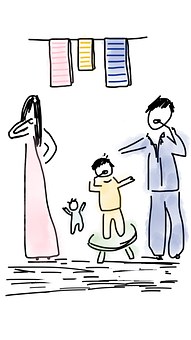Common Childhood Illnesses

Common childhood illnesses are difficult to prevent because they are usually very contagious
. Children are more susceptible to common illnesses, like the cold, chicken pox, and more because of the time they spend in close proximity to other children throughout the school year. One way to help prevent the spread of common illnesses is good hygiene, which should be encouraged in and outside of the home. Simple steps like using hand sanitizer throughout the day can go a long way to making sure children don't lose any school days to sickness. Below are some of the most common illnesses and their usual symptoms. As always, be sure to consult a licensed medical professional with any questions regarding the health of a child.Chicken Pox:
This highly contagious illness is one of the most common to affect children. It is spread through airborne pathogens and is considered most contagious approximately two days before symptoms appear. The lack of symptoms offers a large window for the affected child to spread chicken pox to their friends and other children. Chicken pox is characterized by a fever followed by an itchy rash that can cover a majority of the body. The rash will appear to be blister like and generally can be seen around the area of the head and chest before spreading to other parts of the body. While there is no individual treatment for chicken pox, parents are encouraged to keep an eye on the rash to ensure it does not become infected, which is possible if children are allowed to constantly scratch. Historically, chicken pox is less severe when caught by a child. The fact that the human body builds an immunity to chicken pox once inflicted with the sickness has prompted many parents to purposefully expose their children to chicken pox in order to allow an immunity to build. While this tactic of prevention has worked for many children, parents are reminded to consult with their child's pediatrician before attempting to purposefully induce sickness.
Measles:
Also spread through airborne pathogens, measles can also be contracted by direct or indirect contact with the nose or mouth of an infected person. Measles can spread through sneezing, coughing, kissing, etc. In some cases, it can take up to two weeks before symptoms show. A person with measles can infect a healthy person for up to five days after symptoms have appeared. Fever, runny nose, red eyes, and an itchy rash of red dots are all symptoms of the measles. Rashes caused by measles tend to start on the head and spread downward. The rash will usually turn brown before fading from the skin.
Whooping Cough:
Before a vaccine was created, whooping cough had a fatal reputation. Today, any person who has not received proper immunizations is at risk of contracting whooping cough, named so because of the "whooping" sound made when an infected person inhales after a coughing spell. Symptoms of whooping cough are known to present themselves in two stages. The first stage of symptoms includes mild fever, sneezing, runny nose, and a slight cough. The second stage of symptoms will only manifest if sickness is not treated properly during the first stage. Dry coughs and coughing spells marks the second stage. Some children who have experienced the second stage of symptoms have been reported to turn red or purple. Vomiting between coughing spells is also common. Antibiotics will help cure whooping cough, but it is possible for a person to remain infected for up to six weeks.
Chicken pox, measles, and whooping cough are three common illnesses that affect children, but they are only a few in a long list. Each illness may affect each child differently, but a pediatrician will be able to provide further guidance on what may be causing a child to show certain symptoms. One way to help prevent common illnesses is through a regular immunization cycle. In many cases, immunizations only need to be administered once a year to remain effective. Contact a health professional for more information on common types of childhood illnesses and possible prevention and treatment options.
Common Childhood Illnesses
By: Marshall Littman Get Your Children Involved in Training Your Dog Beauty Tips for Teens Teen Girls Acne Kids And Roller Shades Equals A Whole Lot Of Fun Helping Your Child Build A Credit Score Popular In Teens Who Gonna Say No to Nice Nitro RC Car Airsoft guns – perfect present for your kids Top 5 of Amazon bestseller toys in September 2010 Importance Of Giving Children's Allowance Simple Tips For Child Behavior Help How You Can Effectively Parent Kids With Aspergers Tips For Working With Children With Aspergers